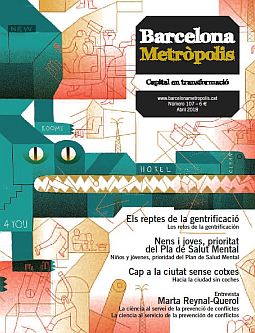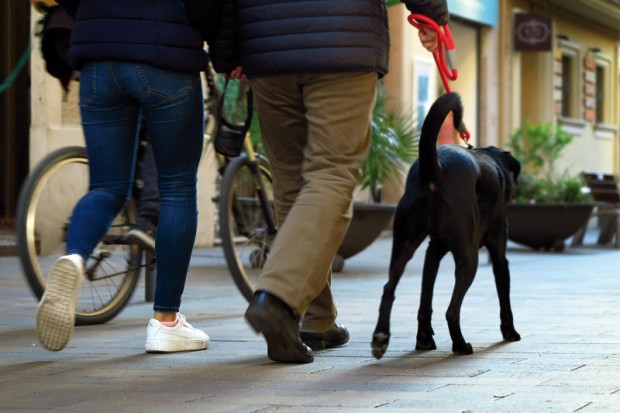Climate change and air pollution have driven the world’s great cities towards a change in paradigm. After a century of cars ruling the streets, the largest metropolises are starting to restrict their use. This revolution, which has already begun in Paris and London, seeks to put the focus on pedestrians once again, and to make cities more liveable, with less asphalt and more green spaces for citizens.
Amsterdam or Copenhagen, the great bicycle paradises, can also teach us a thing or two about the transition towards a sustainable city that prioritizes public transport, bicycles and pedestrians, as well as local commerce.
Barcelona is also moving towards this model of pacified neighbourhoods with the use of superblocks, the expansion of the bike lane network and new investment in public transport, such as metro lines 9 and 10 or the tramway on Avinguda Diagonal. But how can we reduce the millions of cars that circulate through the city each day? Is raising awareness enough, or do we need more aggressive measures? In view of the indirect deaths and the problems caused by the exhaust from motor vehicles, should we limit its use with prohibitions, just like we did with tobacco?
We’re sorry, drivers, it isn’t just a green fantasy or an ecologist utopia: the world’s great capitals are already working to take cars off their streets. In Paris, mayor Anne Hidalgo wants to make the city that gives name to the latest great climate agreement into the first post-car metropolis in history. To do so, she’ll ban diesel cars from circulating in 2024 (since they’re four times more polluting than other motor vehicles) and she’s studying a ban on all other polluting cars by 2030, meaning only electric cars will be allowed to circulate. In order to pacify the city centre, the French capital is working on a very important infrastructure investment with some sixty new metro stations. Just in time for the 2024 Olympic Games, this will improve one of the world’s greatest public transportation networks even more. The socialist government has also expanded the network of bicycle lanes and is trying out its first driverless automatic busses.
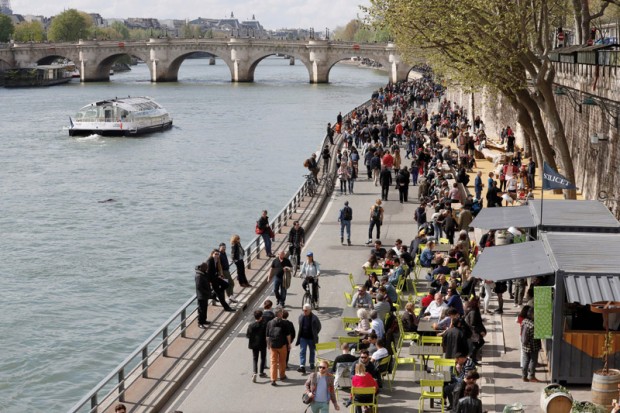
The roads along the Seine in Paris were once used by up to 40,000 vehicles a day. Now that they’re reserved for pedestrians, they’ve become some of Paris’ most popular areas.
Photo: François Guillot / AFP / Getty images
What’s the reason behind all these changes? “The unparalleled challenge of air pollution requires unprecedented action”, declares Mayor Hidalgo, noting the 6,500 Parisians who die each year from pollution. The mayor of Paris is sure that with less cars, the city will be more liveable, and in her green dream the thousands of parking spaces that currently exist will become bike lanes, café terraces and playgrounds. The proof of this increase in liveability are the new promenades on the banks of the Seine: they were once used by up to 40,000 vehicles a day, but now that they’re exclusively for pedestrians, they’ve become one of Paris’ most popular areas.
What other capitals are limiting automobiles? There’s London, which since 2008 has charged a fee for polluting vehicles that circulate in the city, similar to the Ecopass used in Milan. The result has been a reduction in the number of cars in the City, but mayor Sadiq Khan would like to go even further and will encourage new housing and offices to be built without parking garages. In Barcelona, recent attempts to reduce the amount of underground parking has had to face the criticism of the opposition and the real estate agents’ guild, which considers the move “insane”.
The future of automobiles in the city is already the focus of most debates on urban planning. Last October, scores of architects, mobility experts and public transportation activists gathered together at Pompeu Fabra University (UPF) in an Urban Thinkers Campus (UTC) promoted by the Barcelona City Council and the World Urban Campaign (UN-HABITAT), and organized by the Iberoamerican Federation of Urban Planners (FIU). At the gathering, generically entitled “Transition to liveable cities. The Post-Car City”, participants discussed ways of moving toward cities that are “more liveable, sustainable, healthy and safe with the implementation of new models of urban mobility”, according to the words that kicked off the event. At the inauguration, Lluís Brau, FIU president, stated that the future of urban life involves “containing the private vehicle” and pacifying streets, reducing the role of cars. “Mobility is a right”, stated the Barcelona City Council’s Secretary of Mobility, Mercedes Vidal, “but the budget has never treated it as such. Health and education are funded structurally, and the same should happen in this case. This has generated a serious underfunding of public transportation, which will prove very expensive in terms of public health and habitability.”
A global problem: from dream to nightmare
As noted by the urban planner Jose María Ezquiaga, dean of the Architect’s Association of Madrid, the problem with cars is “global”, since the same transportation issues facing Europe also affect big cities in Asia or Latin America. Ezquiaga reminded listeners that, historically, the paradigm of the city was the European model, like Barcelona, based on “compact, continuous and dense” metropolises that allow for mixed use of housing and commerce and optimal mobility, whether by public transportation or on foot. However, with the expansion of the car the opposite model, embodied by Los Angeles, triumphed. “The city expands, flooding the surrounding areas with neighbourhoods made up of individual houses with yards, which can only be accessed by cars”, Ezquiaga explained. It’s the idealized image of the American dream.
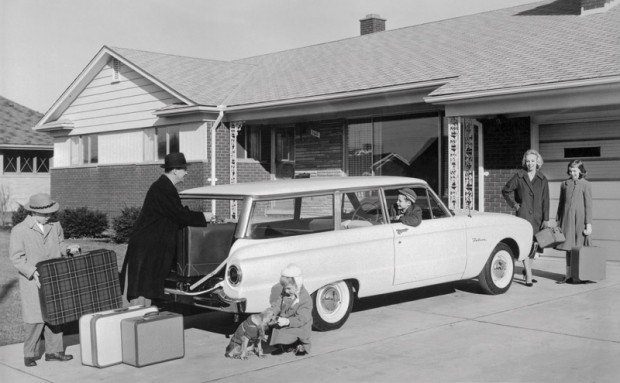
The expansion of the automobile has put the historical model of the compact, continuous and dense European city seriously into doubt. It has lost terrain to the opposite model, the sprawling city embodied by Los Angeles. In the picture, a typical American family from the ‘60s prepares to go on holiday, with their car parked in front of their home.
Photo: Bettmann / Getty Images
“The suburban model has caused people to move farther and farther away from their place of employment”, noted Ezquiaga: this has driven the creation of vast dormitory towns with very low density, where basic services –hospitals, schools, stores– are always far away, and everything involves travel by car. Still, cars aren’t the solution, because at rush hour there are so many vehicles that traffic jams become a part of daily life. “The American dream”, declares Ezquiaga, “is really a nightmare.”
It may seem far away, but this American dream –or nightmare– isn’t so distant. In Spain, the growth of housing developments and dormitory towns populated by single-family homes was the standard from 1994-2009. In Madrid, the population growth of recent years hasn’t taken place downtown but on the outskirts, where the built-up area has doubled. The number of cars circulating has also doubled. “We’ve been building a sort of archipelago, with neighbourhoods and shopping malls that are self-sustaining cells, surrounded by large parking areas. They spring up in the middle of nowhere, which means that the only option is to get there by private vehicle”, states Ezquiaga. This new, sprawling city involves total automobile dependency, and when it becomes overcrowded collapse is inevitable.
A hundred years conquering minds
But if cars are causing mobility problems all around the world, why do we keep using them? Dozens of experts asked the same at one of the activities at the Urban Thinkers’ Campus, a round table entitled “Disputing the cultural hegemony of cars”. “Automobiles are a powerful cultural symbol”, began architect David Bravo, promoter of the “Adéu al cotxe!” (Farewell to cars!) cycle at the Sala Beckett. He’s sure of it, and he insists that our dependency on cars is induced, the result of a social engineering process “without precedent in history, that can only be compared to the expansion of Christianity.” At first, it seems like an exaggeration, but Bravo suggests we look at the way things were a hundred years ago, when society functioned without automobiles. “The car is the element that has changed cities the most and the most rapidly since Neolithic times”, declares the architect from Barcelona, noting the omnipresent character of those four wheels, present in our imaginations from childhood: “what do children play with? With cars!”
Experts note that the expansion of the automobile was the result of a global campaign. It started with the New Deal in the US, when the automobile was seen as an easier way of fleeing the city. But the race to promote the purchase and use of cars wasn’t tied to a single political camp: social democracy was just as active in doing so as was the Eastern Block, Hitler promoting the Volkswagen Beetle or Franco promoting the Seat 600.

The automobile industry has associated the car with essential values like freedom or personal independence, and regimes and governments of all stripes have promoted its use. Above, a scene from the film Thelma & Louise (1991) by Ridley Scott, where a Ford Thunderbird is the key to freedom for the protagonists, played by Susan Sarandon and Geena Davis.
Photo: MGM / Pathé / Album
The automobile industry has associated the car with essential values like freedom and personal independence. On television, we’re constantly told that by buying a car, we’re buying freedom. The cinema has also played its part: in the film Thelma & Louise, for example, a Ford Thunderbird is the key to freedom for the two protagonists, and in Casablanca, set in the middle of the Second World War, the only moment of joy attained by Humphrey Bogart and Ingrid Bergman is when they run off in a convertible. “Later on, in the ‘80s, we reach a climax with series like Knight Rider, where the car itself is the hero”, notes Bravo. However, it’s much more difficult to find examples of the opposite. “Only the movie Falling Down shows the most common experience of the people that drive to work each day: getting trapped in a traffic jam.”
This global love affair with the car isn’t a coincidence, say mobility experts, because the automobile lobby is one of the most important advertisers on the planet, and has been bombarding us with its messages for decades. “There are car advertisements all over the place: in films, on television or in newspapers, but also on public transportation, which should be the competition; we see all-terrain vehicles advertised on the metro or on bus shelters”, states Bravo. “This year [2017], they even plopped a car in the middle of Sants train station, the cathedral of public transportation in Catalonia!” added Ricard Riol, president of the association for the Promotion of Public Transportation.
Those attending the gathering at UPF were also reminded that the automobile industry hasn’t always played clean. In the 1940s, before becoming the mecca of automobiles and a model copied around the world, Los Angeles had an impressive tram network, which the automobile lobby bought up and dismantled to force citizens to turn to private transportation. There has also been a great deal of regularity over the years, with extremely interesting antique advertisements and advertising campaigns ridiculing pedestrians and exiling them to the sidewalk. “In Latin America, cars are still symbols of status and wealth”, noted the urban designer from São Paulo, “and therefore, being a pedestrian means admitting career failure.”
Solutions, but at what cost?
Ricard Riol felt that the debate should focus on the means at our disposal to generate a profound social change. “Nobody debates the fact that traffic is killing and choking us”, he stated. “The problem is when the solutions require changes in behaviour. People want solutions, but they don’t accept changes.” Still, the numbers speak for themselves: there are too many cars on our streets, and they’re given preference. In Madrid, 61% of streets are asphalted, even though they aren’t even used for 38% of trips. The same happens in Barcelona: just one of every four trips is in a private vehicle, but cars still dominate our streets and public spaces.
How can we fight cars’ winning image? One option involves making public transport “sexy”. Geographer Francesc Muñoz offers the example of the tram, which has a very positive reputation among Barcelonians in terms of perception, aesthetics and sustainability. Another way of fighting the automobile is by associating it with the pollution it causes. How? By following the example of the anti-tobacco laws. Although it now seems faraway, tobacco smoke was once just as omnipresent as the smoke from cars: people smoked in universities, hospitals, on planes and in restaurants, and it was impossible to imagine a world without smoke. Films also played a key role in promoting the image of smoking, and the values of glamour and independence associated with the cigarette were never questioned. But the determination shown by public administrations in protecting citizens’ health eventually defeated the tobacco companies. According to the experts present at the gathering at UPF, the similarities are evident because, as noted by Anne Hidalgo, the car is also a global health problem.
But doesn’t the electric car solve these pollution problems? “With the electric car, the sector makes an attempt at greenwashing, to convince us that everything’s changing so that everything can stay the same”, notes David Bravo. At the round table where these opinions were expressed, there was a general consensus on this change of image: green vehicles only “shift the blame”, meaning that instead of pumping exhaust out of their tailpipes and polluting the city, they help to pump smoke out of the power plants where the energy is produced. Plus, a city full of cars, be they electric or not, is a city of traffic jams where pedestrians are forced to play second fiddle.
Although some of the analyses and predictions made at the thinkers’ campus on the city may seem radical and apocalyptic, the defenders of a car-free city aren’t against automobiles in general. Most of the experts agreed that “cars are a problem when they’re under-used”, meaning when they are mostly empty, just like the million vehicles that cross Barcelona on a daily basis with an average occupancy of 1.14 individuals per car. “If we could get occupancy rates of 2.5 individuals, we wouldn’t be having this debate”, clarified Pau Noy, a deputy managing director at Barcelona Metropolitan Transport (TMB). Noy insists that the car won’t ever disappear entirely, because there will always be logistical necessities or individuals with special needs. The goal, according to these experts, is to take away its privileged position.
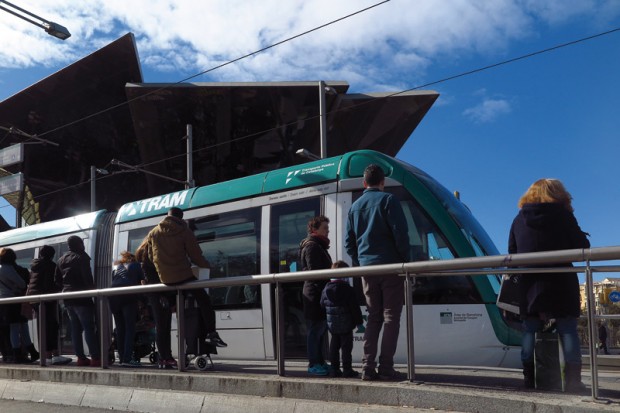
The Tram has a very positive reputation among citizens in terms of perception, aesthetics and sustainability. Making public transportation attractive, as happened with the tram, is one of the best ways of combatting the traditionally positive image of the car.
Photo: Vicente Zambrano
Barcelona can be decongested
Urban designers insist that there are no miracle solutions for mobility in cities, and that the best recipe has been around for centuries: promoting public transportation and restricting the use of private vehicles. The problem is that in Barcelona, just the opposite has happened. “As the city got more and more congested, we increased the road capacity”, stated Pau Noy. Classic examples of the application of this policy are the progressive creation of the Ronda del Mig and the creation of the Ronda del Literal and Ronda de Dalt in 1992, roads designed for private vehicles that were developed without making a similar investment in public transportation. The economic recession has made the situation even more difficult, with budget cutbacks that affected services and prevented the renewal and growth of the public transportation fleet. The problem is that it takes political bravery to take on sustainable mobility, because any politician who tries to take cars out of our streets is sure to lose plenty of votes.
But is a car-free Barcelona technically possible? Pau Noy has multiple studies by TMB that show that it is, since with an appropriate investment public transportation could cover all our mobility needs. In fact, 69% of car trips currently happen between places with alternatives, like metro or tram. TMB calculates that metro frequencies could be doubled with the use of automatic trains, and the capacity of regional train lines could be increased with larger trains and taking advantage of the under-used high-speed train tunnel. Joining the Llobregat and Besòs tram lines via Avinguda Diagonal would multiply the current offering by three, and with the expansion of the network of bike lanes –which by 2019 will be over 300 km long– bicycle use could increase fivefold, eventually covering 10% of all trips.
What would the benefits of all this be? “First of all, there would be a reduction in accidents, and pollution levels would drop to zero”, explains Pau Noy. Another clear consequence of having emptier streets would be that the public space open to citizens would increase fivefold. Not only would plenty of lanes be reclaimed on plenty of roads, the space dedicated to parking would also be reduced. And no, we’re not talking science fiction: “in Europe –excluding Spain– there are already plenty of cities without emissions”, notes Noy. It’s all an issue of political willpower. It’s also a matter of time, according to the experts, as the end of oil and the effects of climate change will force us to change our way of life sooner than we think.
New technologies could play a key role in the evolution of mobility. For example, there are more and more carsharing platforms with possibilities for growth. In addition, some are optimistic about the development of self-driving cars, which would circulate without a driver and could transport several people at once, as something halfway between a taxi and a bus. Mobile apps could also improve travel. Rikesh Shah, the head of commercial innovation at Transport for London, explains the benefits of sharing all sorts of information on public transportation in real time, such as the state of metro or bus lines, the exact arrival time of a train at a station or the status of accidents or maintenance work. Thanks to this effort in open data, over 600 independent applications have been created to provide information to 40% of users on the status of service, with programs that automatically propose route changes whenever problems arise.
In Barcelona, the application of the new T-Mobilitat public transportation pass, planned for 2019, could be a good opportunity to move towards multimodal transportation and bring about a change in citizens’ mentality. “T-Mobilitat could promote best practice in many different ways”, notes architect David Bravo. “The pass could offer a discount to people who use Bicing, people that recycle at the Punt Verd or that buy at local markets.” New technologies could also improve Bicing: at the symposium, it was noted that the use of bicycles could be encouraged, and they could be more effectively distributed throughout the city by offering compensation to users of less-popular routes, such as those between the beach and the steepest neighbourhoods.
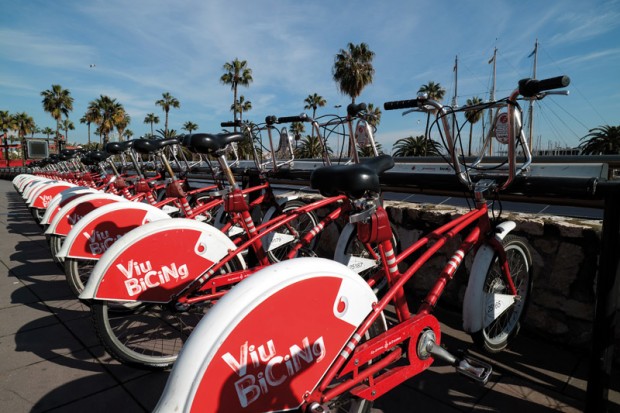
The growth in Barcelona’s network of bike lanes, which will surpass 300 kilometres in 2019, will make it possible for transport by bicycle to increase fivefold, eventually making up 10% of all trips.
Photo: Vicente Zambrano
The bicycle as a metaphor
As a matter of fact, the bicycle has led the transformation of many cities across Europe, often with climates much more difficult than ours. “In Nordic countries it often snows, and below-zero temperatures are common; nevertheless, 40% of people bike to work every day” explains Mark Wagenbuur, founder of the blog BicycleDutch.nl. According to this Dutch expert, bicycle use is a matter of habit and culture. “But habits and culture can change.”
One example of this is the city of Amsterdam, one of the cyclists’ paradises of the North. “Now, bicycles are so essential that the first minister pedals to the palace to inform the king when a new government is formed, but 50 years ago things were very different” notes Wagenbuur. With the boom in prosperity of the ‘50s, cars began to conquer space and minds in the Netherlands, and the pressure they put on cities led to the destruction of entire medieval neighbourhoods and converted public squares into enormous parking lots. “But eventually, people got sick of their heritage being destroyed”, he remembers, with squatters who stood up to the destruction of historic buildings and families that drove the Stop de Kindermoord [Stop the Child Slaughter] movement. Through protests and civil disobedience, this movement demanded the pacification of automobile traffic, which killed 400 children just in 1971. Finally, the state began to change its priorities and the first exclusively pedestrian city centres were born.
Copenhagen, the other great cyclist capital, underwent a similar process. In the ‘70s, only 10% of trips were made by bicycle and cars were everywhere. However, a continuing policy of investment brought about a change, and bicycles now account for 41% of trips. Plus, new cycling infrastructure continues to be built. Now, four-lane bicycle superhighways are being promoted (because there are so many bicycles that there are jams at rush hour), as are up to 16 new bridges just for two wheels. In fact, in the Danish capital debate isn’t focused on the bicycle, but on cars. Urban design is still based on the automobile, and although 55% of vehicles at rush hour are bicycles, cars still have priority on most roadways. Therefore, the need is to achieve “spatial justice” and put citizens at the centre of urban planning.
In Barcelona, the rise in bicycle use in recent years gives us reason to be optimistic. After its initial boom, Bicing celebrated its 10th anniversary as a fully consolidated institution with over 6 million users. It also kicked off this year with an ambitious change in operator that will guarantee 24-hour service, expand the number of stations and make them all mixed, so that they admit both normal and electric bicycles. In addition, the expansion of the network of bike lanes will allow everyone to have one less than 300 metres from home. “There are few investments that are as cost-effective as those having to do with bicycles, in terms of the relationship between cost and transformative power”, explains City Council member Mercedes Vidal.
In Denmark and the Netherlands, the formula for success is the coexistence of three types of lanes: fast lanes, exclusively for cars; mixed lanes, with segregated roadways, and neighbourhood streets where cars circulate slowly and cyclists and pedestrians always have priority. The resulting design is a grid city with multiple layers of pacified traffic, or the very model that has caused so much controversy in Barcelona: the superblock.
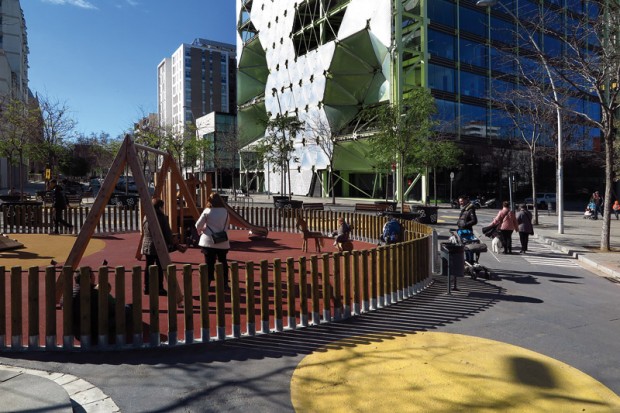
With the development of superblocks like this one in El Poblenou, the City Council wants to reduce the total area of public space reserved for wheeled transit from today’s 50% to an eventual 30%.
Photo: Vicente Zambrano
Citizens, at the centre
“With the development of superblocks, we hope to reduce the public space dedicated to wheeled transport from 50% to 30%”, explains Ton Salvadó, architect and director of Urban Model for the City Council. It’s the same old recipe: increasing quality of life in the neighbourhoods by pacifying traffic, converting many of our current roadways into local or neighbourhood streets. “The city is stretched to the limit” notes Salvadó. “In the metropolitan area, 3500 premature deaths are recorded each year as a result of pollution, 11,000 a year are wounded in accidents, and there are many other health problems related to being sedentary, noise pollution and a lack of green space.”
In order to understand the potential of this project, we only need to look at our existing superblocks, Gràcia and El Born, two of the neighbourhoods most highly valued by the real estate and tourism market. Salvadó insists that once the process is completed, hundreds of roadways and streets will have become spaces for neighbours, with playgrounds and green areas. The plan is to reduce the number of cars and for those that remain not to park on the surface. “We want the street to be seen as an extension of domestic life, as a comfortable space”, concludes the architect.
This isn’t a local debate, but a global issue. The 20th century belonged to cars; do we want the 21st to belong to pedestrians?



